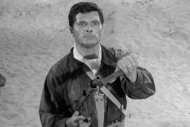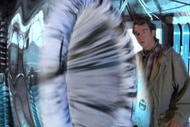Create a free profile to get unlimited access to exclusive videos, sweepstakes, and more!
Emmy Contender: Come stay in the Hotel Denouement from A Series of Unfortunate Events

Welcome to Emmy Contenders 2019. This month, SYFY WIRE is speaking to a long list of actors, artists, and artisans whose work earned them Emmy nominations this year. Today we speak with Bo Welch, the Emmy-nominated production designer for Netflix's A Series of Unfortunate Events.
When production designer Bo Welch read The Penultimate Peril, the 13th book in Lemony Snicket's 14-volume A Series of Unfortunate Events series, he says he nearly passed out. "From a production standpoint, looking at what we'd have to figure out was pretty daunting," Welch recalls. "It was going to be fun, too, but I was dreading it. It would trigger panics and migraines. Oof — I'm starting to get sweaty just thinking about it!"
Welch's distress was triggered by the thought of designing and constructing the Hotel Denouement, the Netflix series' most complex set. The massive seaside resort needed to accommodate nearly all of the characters accumulated during the course of three seasons, which meant the lobby had to be huge. And the hotel needed other features, too: a working elevator, multiple guest rooms, a restaurant, a kitchen, a laundry, a steam room, a rooftop pool, a basement, subterranean passages, and an exterior reflecting pond outside. Even trickier, the structure needed to convey a sense that there were secrets around every corner.
"I spent a hellacious number of hours trying to figure this thing out," Welch says. "It involved engineering and other things that you don't ordinarily concern yourself with in designing a television show."
Welch took inspiration from both real and fictional buildings, among them the Overlook Hotel in The Shining, The Bradbury in Los Angeles, and The Beekman in New York, which he discovered on a scout for the 2012 Men in Black 3 with director Barry Sonnenfeld. "Back then," Welch says, "it was in horrible disrepair, and the paint peeling off the walls contained lead, so it would have cost millions to make it safe to use. But the central atrium with the skylight in the ceiling was so cool. And the Bradbury had the same vibe, with its cast-iron mixed with glazed brick and wood. Both of them were gorgeous."
To evoke the atmosphere of those buildings for the Hotel Denouement — whose rooms are organized in accord with the Dewey Decimal System — Welch combined their designs with the look of a bank of pull-out library card-catalog drawers for the building's façade. Then he started creating spaces inside that were just functional enough for the show's purposes. The main elevator only rose two and a half floors (there was a separate one that dropped down into the subterranean set). The rooftop pool was 4 feet deep but was only filled with digital water. The fountain pond, several floors deep in the story, became less than a foot deep for the show.
The color scheme was the easiest part. Thinking ahead, Welch had already assigned colors in different episodes — the "Grim Grotto" block, for instance, was a dismal red. The "Penultimate Peril" got a lot of green — a color preference Welch picked up working with Alfonso Cuarón on A Little Princess. When Cuarón's friend Guillermo del Toro also went all-out on green in The Shape of Water, Sonnenfeld took notice. "They out-greened us!" he told Welch after seeing the film.
"It was as green as you can get," Welch says, with a laugh. "But ours was a little more than just pure green. And ours became a neutral." Proportion-wise, "75-80 percent of the images in 'Penultimate Peril' are various shades of green," he says, "punctuated by other colors chosen to amplify elements in contrast." For example, when Larry Your-Waiter is dunked in the curry, the red sauce stands out on Olaf's jacket. "You could almost mistake it for blood," Welch says. "In our world, it's darkly comedic."
From there, Welch created carpets and wallpapers for the hallways that recalled The Shining ("to make you a little nervous") and wallpaper for the lobby with flamingoes and palm trees ("to foreshadow our next stop on this ridiculous journey").
"One of my original ideas was to do wallpaper that looked like books," Welch says. "But we had already done something like that in the 'Ersatz Elevator' episodes, in the game room." The tropical wallpaper is more subtle — dull and muted. "You'd have to really stand in front of the wallpaper to see it," he says. "It might not come across on the screen, but if you accumulate enough of these ideas, I think their overall effect does come across."
Welch's main problem was time, which was in short supply. Two days before the shoot, director and producer Sonnenfeld took a look at the set and panicked, thinking it would require another six months to finish. "Everyone was kind of scared, and he was scared to death," Welch says. "Because we were still welding and painting. We just had to take a deep breath and have tremendous faith in our crew."
In the end, all the hotel furniture and furnishings made it in place in time. Afterward, they started to disappear — and not into storage. "There was kind of a frenzy of people wanting things from this set," Welch says. The show's star, Neil Patrick Harris, made off with a moving van filled with custom-made loot. Sonnenfeld scored some cameo paintings that featured his portrait (they're seen in the Indian restaurant and subterranean library). And Welch absconded with four of the rooftop pool's chaise lounge chairs.
"This stuff all looks great, but it's a trap," he says, with a laugh. "You look at stuff and you go, 'Oh my god, I gotta have that.' But well-chosen pieces that work together in the context of the show lose their impact out of context." Still, he says, "They're lovely souvenirs."





























